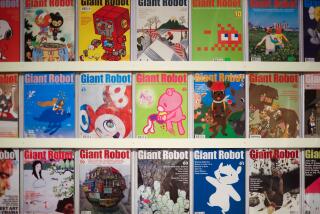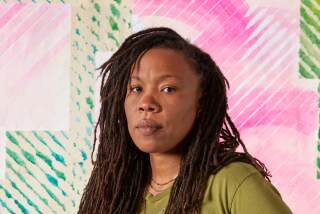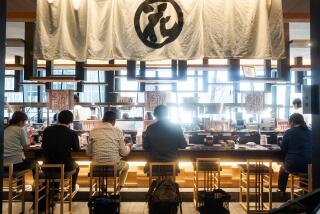A Meeting of the Twain - FOLLOWING THE BRUSH: An American Encounter With Classical Japanese Culture <i> By John Elder</i> ; <i> (Beacon Press: $18; 172 pp.) </i>
It is not often that an American writes a Japanese-style book about Japan. Successful books of this sort are rare indeed. But John Elder has just produced a small masterpiece in the genre.
“Following the Brush” is a collection of eight linked essays, all deriving from a remarkable year that Elder and his family spent in Japan.
At home, Elder is a professor both of literature and of environmental studies at Middlebury College. As a literary type, he got interested in the poetry of Basho. As an environmentalist, he was puzzled by the conflict between the well-known Japanese love of nature and the equally well-known Japanese willingness to hunt rare species of whales, build power plants in the middle of famous views, and clear-cut forests in other peoples’ countries. He began to wish to see Japan.
But he did not hop on a plane. First he took two years of Japanese at Middlebury College. Then he made a preliminary visit alone. Only in 1990 did he and his wife and their three small children set out for their year abroad.
The plunge was total. They did not go to Tokyo, nor to the familiar campus of a university. Instead they went to Kyoto, the ancient capital. There they rented an apartment in a section of the city chiefly inhabited by artisans and shopkeepers. With some difficulty they enrolled their children in the local elementary school--blond Rachel in the sixth grade, red-haired Caleb and brown-haired Matthew in the third. Though the school was a century old, these three were the first gaijin (foreign) students it had ever had.
Narasaki-sensei, the principal, was reluctant to take the kids. As he pointed out, neither he nor any of the teachers spoke English, and the children only a little Japanese. Mightn’t an international school be better?
But take them he eventually did, and all three flourished. Evenings they would be practicing brush strokes with their father, having first ground their ink. Days would be spent learning both the simple hiragana alphabet and the astonishingly complex kanji . “Each of our children,” Elder writes, “came back from Japan with a calligraphy set and a soroban , or Japanese abacus, that are still among their most prized possessions.” They also came with good Kyoto accents--and in the case of the boys, happy memories of the rather violent school fencing classes on Saturday mornings. Rachel, meanwhile, was doing a class in nanga , a special kind of watercolor painting.
As for the father, what didn’t he do? Well, he didn’t hang out with other foreigners. Early on, he joined, as its only gaijin , one of the Kyoto go clubs-- go being that chess-like Oriental game so complex that no computer has yet been able to beat even a moderately competent human player (plenty of computers are grand masters at chess). He studied calligraphy with a master. He traded weekly conversation lessons with a doctor’s wife named Hitomi--first an hour of English, then an hour of Japanese. He wandered around the temples where Basho wandered, 300 years ago. He became good friends with Uzawa Hisa, the distinguished Noh-play actress who is one of the first of her sex to be allowed on the Noh stage. And, not incidentally, he learned a great deal about the eating of whale meat, beginning the day it was served to his three children as part of their hot lunch at Kiyomizu Elementary.
From his year, Elder emerged with a feeling for things Japanese that may be unmatched by any American works laid in Kyoto, such as Jay McInerny’s much-praised novel “Ransom.” McInerny is doing a kind of Hemingway-in-Japan-- he knows the esoteric stuff about Zen, one hand clapping, etc., and you, the reader, are to be awed and impressed . . . and kept half- outside.
But Elder invites you in, though in the most Japanese of ways. That is, slowly. There is no Instant Japan here; there is, instead, a test of the reader’s patience.
Anyone who knows Japanese culture at all knows that apprenticeships tend to be long. The person who wants to learn pottery-making may have to sweep floors for a whole year, and mix clay for a whole second year before attempting his or her first pot. Uzawa Hisa, the Noh actress, did behind-scenes work for seventeen years before she was finally allowed on stage. In somewhat the same way, the reader of this book must (unless prepared to cheat) go through the long first essay, and get a feel for Japanese characters before being allowed to glide into the other seven.
That first essay is quite literally a lesson in how to write Japanese, and how to appreciate what it is that you are writing. I freely admit to having found most of it tedious, despite its intense Japanese-ness. But by the time I finished it, I was able to listen more quietly than I usually can, and I was ready to be admitted to the book.
Once in, I learned more than I have anywhere else about the strengths (and weaknesses) of Japanese education. The exam hell may not be a myth, but it is matched by the classroom heaven.
I also learned about whale meat: that, to begin with, it is a beloved and expensive luxury in Japan, currently costing $30 to $75 a pound. The decision to serve a little bit at Kiyomizu Elementary was a conscious decision to support tradition, much as if an American school occasionally served filet mignon and lobster. Beyond that, I learned that many Japanese feel they should be an exception to whaling rules, as some Eskimos are in Alaska, or some Native Americans are with salmon. Most of all, I learned that Japanese environmentalism starts with little things like bonsai trees, and often fails to consider big ones. That’s the exact opposite of American environmentalism, which starts with big ones, like wilderness areas, and often fails to consider little ones.
It is easy to get carried away with a book this good. I am tempted to say that to read it gives a better sense of Japan than an actual visit might. That may not be so. What’s definite is that reading it is a memorable experience.
More to Read
Sign up for our Book Club newsletter
Get the latest news, events and more from the Los Angeles Times Book Club, and help us get L.A. reading and talking.
You may occasionally receive promotional content from the Los Angeles Times.







